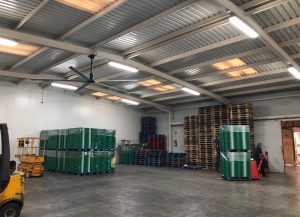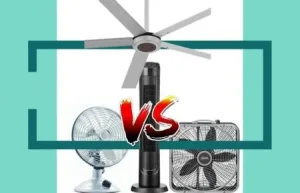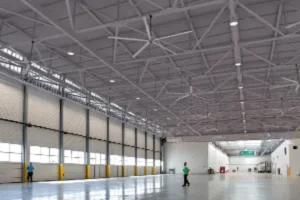Factories and large commercial spaces often feel oppressively hotter, causing discomfort and lowered efficiency. This struggle can intensify in hot summer months, where stagnant hot air builds up. Yet there’s a remedy: adjusting fan placement and position can help cool a room, reduce energy costs, and revitalize productivity.
For maximum cooling and balanced air circulation, consider placing fans both high and low. High-mounted fans disperse trapped warm air, while fans closer to the floor bring in cooler air. Combining these positions helps circulate air efficiently, delivering a consistent breeze. If you have windows, using a window fan to pull in cool air (when cooler outside) or blow hot air out also improves results.

Installation location of the hvls fan in the factory
Imagine a room with fans scattered randomly or mounted at awkward angles. You might feel pockets of hot or cold air, and certain areas remain stuffy, lacking the consistent breeze you crave. Proper fan placement transforms a large environment—like a gym, warehouse, or multi-level facility—by evening out temperatures and freshening the atmosphere.
By improving airflow, fans often reduce the reliance on heavy-duty cooling systems like air conditioning units. When fans are placed high, they move stagnant hot air down to occupant level during colder months, and they can push that same warm layer out in the summer if you open vents or windows. This synergy slashes operational expenses across busy facilities.
A ceiling fan at an optimal height circulates a wide radius of air, especially if you pair it with smaller floor or tabletop models. High overhead fans capture air around the upper zone, while units closer to the ground channel cooler air where it’s needed. The result? Enhanced comfort throughout the room, which could be a major productivity boost in an industrial or commercial context.
People often question whether a fan can actually cool the environment. Strictly speaking, fans do not lower the ambient temperature; instead, they create a breeze that makes occupants feel cooler through evaporative cooling on the skin. Yet, combined with strategic fan placement and open windows, a fan can effectively cool a room—or at least lower perceived heat.
If outside air is fresher or the outside temperature is lower than indoor conditions, a fan positioned near a door or fan in a window can channel that comfortable climate indoors. In factories or large halls where the temperature is cooler in shaded outdoor areas, drawing that air inside can bring significant relief.
In cooler seasons, reversing the direction of a ceiling fan helps redistribute warm air that accumulates near ceilings. This means you can cut back on heating expenses. Conversely, in hotter weather, keep the blades moving counterclockwise to push cool air downward, ensuring a refreshing wind-chill for people in the room.
Yes—air circulation is the hidden gem of thermal comfort. When air remains stagnant, it accumulates humidity, odors, and heat, leading to unpleasant working or living conditions. By leveraging hvls ceiling fans, floor units, or carefully positioned smaller fans, you unlock a powerful tool for ventilation and air quality improvements.
Continuous air movement helps break up clusters of hot air. It can also sweep away pollutants or dust, especially in industrial settings, promoting a healthier environment. When the air flows evenly throughout the room, occupant comfort rises significantly, and it’s easier to maintain stable conditions even when production lines generate extra heat.
Better air circulation can lighten the load on your air conditioner because fans assist with temperature equalization. If you have very high ceilings, air rises and collects above occupant level. Bringing it down to maintain stable conditions saves energy, especially if you incorporate ceiling height data when choosing your fans. This synergy can help you plan for the cooling of the room with minimal expense.
Absolutely. Not every space demands the same fan design. While a ceiling fan works wonders for large areas, there are times when a box fan or a window fan can be just as beneficial, particularly in smaller rooms or for quick on-the-spot solutions.
A box fan is often placed on the floor or a table. You might put a box fan near a doorway to pull air from cooler zones. Box fans excel at concentrating a powerful breeze in a specific direction. By aiming it carefully, you can direct a strong current of cooler air toward areas where employees or occupants gather.
A window fan can draw air from outside if it’s cooler outside, or it can be reversed to blow hot air out if the interior is stuffy. This approach brings a level of airflow control that can significantly improve air circulation. For instance, place one fan in a window pulling fresh air inward, while another is expelling stale, warm air out. This cross-ventilation tactic is a tried-and-true way to cool spaces without ramping up AC usage.

Different types of fans
When we speak about maximizing the cooling effect, we’re actually referring to how effectively fans move air, reduce hot spots, and create a comfortable environment. Setting up multiple fans in strategic places is often the simplest path to success, especially in large factories, gyms, or room in a house with poor air flow.
Over time, you’ll notice certain areas get warmer, especially corners without good ventilation or spots near machinery. Placing fans intentionally to blow air across these trouble zones ensures that cooler air displaces the pockets of trapped heat. If your building has long corridors or partially open walls, harness that natural draft by aligning fans so they complement the existing breeze.
Sometimes using two fans in one large area has more impact than a single fan. One can be angled downward to push cool air across the floor, while the other is angled upward or sideways to cycle air inside effectively. This is especially handy if you’re running an air conditioner in tandem, as the fans help distribute that cooled air into every corner.
Whether you’re mounting a ceiling fan, or hooking up a window fan, fan installation is crucial. Poor installation leads to vibrations, inefficient performance, or even hazards. But done right, it can significantly improve air circulation.
Large fans are known for their potential to stir massive amounts of air. If they’re misaligned or installed off-center, they can create uneven air pressure or fail to circulate air thoroughly. Balancing the blades is vital to keep noise levels down and performance up.
Ceiling fan installation stands out in settings where comprehensive coverage is essential. A well-placed overhead unit can manage the air in the room over a broad radius, which suits multi-purpose venues, workshops, or tall-lobby areas.
Large spaces—like sports complexes, distribution centers, or academic auditoriums—benefit from a single overhead fixture that sweeps air in broad arcs. This arrangement also reduces clutter at ground level, preventing the risk of employees tripping over cords or stands.
One of the most advanced overhead solutions involves hvls ceiling fans (High Volume, Low Speed). These fans typically feature large diameters and slow rotational speeds that produce gentle but far-reaching breezes. The result is a dramatic improvement in occupant comfort without the whirlwind or noise sometimes associated with small, high-speed fans. By investing in these specialized products, facilities often see major benefits in occupant well-being and cooling power.
Many industrial operations rely on huge overhead fans colloquially known as big ass fans. These robust, fans typically measure several feet in diameter and are designed to handle vast open areas in manufacturing and warehousing.
While fans do not reduce the air’s temperature through refrigeration, they make environments feel cooler by increasing evaporative sweat reduction on the skin. The breeze also prevents pockets of stagnant hot air, which can cause discomfort or degrade air quality. So yes, large fans can actually cool in the sense of providing a noticeable, comfortable effect.

Large industrial fan in large space
Many wonder if it’s better to point a fan upward (pulling air upward) or downward (pushing air onto people). The position depends on your current climate control goals and the outside the room conditions.
Downward airflow is typically the default in summer. It directs breezes onto occupants, letting them enjoy the cooling affect from constant air contact. If you also open windows or doors, you can vent out excess heat and bring in air outside more easily.
During colder seasons, an upward tilt or reversed blade direction can drive the warmer air collecting near the ceiling down the walls and back to floor level. This approach helps you hold onto heat instead of letting it linger overhead, untouched, which is especially useful in large industrial settings where heating costs can skyrocket.
Finding that sweet spot for placement for optimal air circulation may involve trial, error, and observation. Yet there are tried-and-tested guidelines that work wonders in nearly any industrial or commercial scenario.
Apart from overhead fans, you might consider tower fans, portable air purifiers, or an evaporative system. Large, well-designed fans also mesh well with modern environmental management solutions in a whole house or multi-floor building. Blending multiple strategies ensures that as fresh air enters the room, it disperses widely and quickly, letting you keep your entire operation comfortable.
How do I boost cooling inside the room if the air outside is scorching?
Point fans so they drive hot air out. If air outside is genuinely hotter, keep windows closed during peak heat and wait until it’s cooler outside to open them. Then, reverse your fan placement to draw in the refreshing night breeze.
Is using one fan enough for large industrial floors?
Often, one fan may not suffice. Large spaces benefit from two fans or multiple fans placed at strategic intervals, possibly including a powerful overhead unit. This setup ensures even air movement across wide zones, so employees can keep cool from end to end.
Does reversing a ceiling fan in winter really help?
Yes. Warm air drifts upward, so reversing the fan blades pushes it back down. This simple switch helps maintain an even temperature, lowering heating costs in large or tall rooms.
Will a fan placement for optimal air alone reduce the need for AC?
A well-planned placement for optimal air circulation can significantly diminish the use of traditional cooling systems, though it may not eliminate them altogether in extremely hot climates. However, it does lessen the burden on air conditioning, saving energy.
Can fans really lower the temperature or do they just move air around?
Fans don’t reduce temperature directly; they create a cooling effect by speeding up sweat evaporation and breaking up heat pockets. This makes individuals feel cooler, making it an extremely efficient way to cool spaces where the air inside might be stagnating.
Is it important to measure ceiling height before ceiling fan installation?
Yes. Ceiling height determines if you need downrods or specialized brackets. Overly high ceilings may require extended mounts to ensure the fan can blow the air effectively where people gather.
| Fan Type | Best For | Key Benefit |
|---|---|---|
| Ceiling Fan | Large open rooms, commercial floors | Wide coverage, no floor clutter |
| Box Fan | Spot cooling, near doorways/windows | Direct, powerful airflow |
| Window Fan | Drawing in outside air or pushing out | Improved ventilation, cross-breeze |
| Tower Fans | Narrow corners or modern offices | Sleek design, oscillation |
| HVLS Ceiling Fans | Massive industrial or sports facilities | High volume, low speed, broad area coverage |
Angle of Fan (Degrees) | Typical Cooling Benefit
------------------------------------------------
0° (Upwards) | Redistributes Warm Air
30° (Tilt Down) | Mild Breeze at Mid-Level
45° (Tilt Down) | Direct Breeze on Occupants
60° (Tilt Down) | Strong Focused Airflow
*Note: Actual results vary based on fan power, air pressure, and incoming air conditions.
A sprawling distribution center found that simple fan placement changes significantly reduced internal temperatures. They placed a single fan overhead near the loading bays to push out hot air from deliveries. Floor-level fans and a window fan in administrative offices ensured a continuous, refreshing loop of cooler air. The facility manager remarked:
“By adding a big overhead unit and placing smaller fans strategically along entryways, we practically halved the number of heat-related complaints. It’s cost-effective and ensures everyone stays comfortable.”
Achieving proper air circulation means analyzing how air enters the room, how it flows, and where it exits. Whether you place a ceiling fan overhead, put a box fan in strategic spots, or rely on window fan systems for cross-ventilation, a mindful plan yields better comfort and significant energy perks.
Ultimately, selecting the best fan setup and perfect position depends on your space’s unique layout. Fans not only help you feel cooler, but they also guard your bottom line through energy savings. If you’d like personalized advice on installing or optimizing large overhead fans, consider reaching out to experts who specialize in advanced solutions for factories, warehouses, gyms, schools, and other facilities that demand strategic, high-volume ventilation. You’ll see how effectively well-placed fans can change the entire dynamic of an environment, enabling you to keep cool and comfortable all year round—without spending a fortune on climate control.

Hi, I’m Michael Danielsson, CEO of Vindus Fans, with over 15 years of experience in the engineering and design industry. I’m here to share what I’ve learned. If you have any questions, feel free to contact me at any time. Let’s grow together!